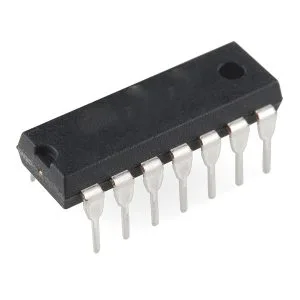7474 IC D-type Flip Flop Counter or Delay Flip-flop
7474 flip-flop IC utilizes the Schottky TTL circuitry to produce high-speed D-type flip-flops. Each flip-flop has individual clear and set inputs, and also complementary Q and Q`(bar) outputs.

7474 Pinout Configuration
| Pin Number | Pin Symbol | Name | Description |
| 5,9 | 1Q / 2Q | Output | Output Pin of the Flip Flop |
| 6,8 | 1Q’(bar) / 2Q’(bar) | Complementary Output | The inverted output pin of Flip Flop |
| 3, 11 | 1CLK / 2CLK | Clock Input Pin | These pins must be provided with a clock pulse for the flip-flop |
| 1,13 | 1CLR (bar) / 2CLR (bar) | Clear Data | Resets the flip-flop by clearing its memory |
| 2,12 | 1D /2D | Data Input Pin | Input pin of the Flip Flop |
| 4, 10 | 1PRE (bar) / 2PRE (bar) | PRE Input | Another Input pin for Flip Flop. Also referred to as a set pin |
| 7 | Vss | Ground | Connected to the ground of the system |
| 14 | Vdd/Vcc | Supply Voltage | Powers the IC typically with 5V |
Specifications
| Product Attribute | Attribute Value |
| Product Category: | Flip-Flops |
| Number of Circuits: | 2 |
| Logic Type: | D-Type Flip-Flop |
| Polarity: | Inverting/Non-Inverting |
| Input Type: | Single-Ended |
| Output Type: | Differential |
| Propagation Delay Time: | 44 ns |
| High-Level Output Current: | – 5.2 mA |
| Low-Level Output Current: | 5.2 mA |
| Supply Voltage – Min: | 2 V |
| Supply Voltage – Max: | 6 V |
| Minimum Operating Temperature: | – 40 C |
| Maximum Operating Temperature: | + 125 C |
| Function: | D-Type |
| Number of Channels: | 2 |
| Number of Input Lines: | 8 |
| Number of Output Lines: | 4 |
| Operating Supply Voltage: | 2 V to 6 V |
Note: Complete Technical Details can be found in the 7474 datasheet given at the end of this page.
Like every other chip in the 7400 series, this IC must be connected to power before you can use it. Most 7400 ICs support a VCC voltage of 5V. One difference between the HC and LS version of the chip is that the 74HC04 supports 2V to 6V, while the 74LS04 supports only 5V.
How to use 7474
Using a Flip-Flop is pretty straightforward. Simply power the IC using the Vcc and GND pin. As told earlier each flip-flop operates independently, just connect the input signals 2 and 3 for using the 1st flip-flop and you will get the output at pins 5 and 6. Pin 3 should be provided with a clock source normally a PWM signal from an MCU or 555 timers is used. The pin can be used to clear the data and reset the flip-flop by making it high. The complete working of the Flip flop can be understood by looking at the function table below. The symbol “X” indicates don’t care and the up-arrow indicates the rising edge of the signal.
| INPUTS | OUTPUTS | ||||
| PRE (bar) | CLR (bar) | CLK | D | Q | Q (bar) |
| L | H | X | X | H | L |
| H | L | X | X | L | H |
| L | L | X | X | H | H |
| H | H | H | H | L | |
| H | H | L | L | H | |
| H | H | L | X | Q0 | Q0 (bar) |
You can also simulate the IC to check if it would work as desired. Here I have used logic state and logic bits to view if the IC functions as it is supposed to, but you can replace them with the actual circuitry of your application to check if it would suit your needs. The gif file shown below can be verified with the truth table above to make sure that the IC works as desired.

Applications
- Used as Shift Registers
- Memory/Control Registers
- Buffer Circuits
- Sampling Circuits
- Latching devices






